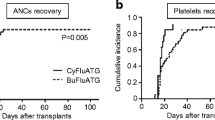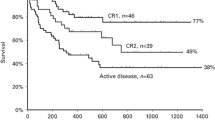Abstract
We report the feasibility and efficacy of a fludarabine/busulfan-based dose-reduced conditioning regimen followed by stem cell transplantation from related (n=19) or unrelated HLA-matched donors (n=18) in 37 patients with myelodysplastic syndrome (MDS) or secondary acute myeloid leukemia (sAML) who were not eligible for a standard myeloablative conditioning regimen. The conditioning regimen consisted of fludarabine (120–180 mg/m2), busulfan (8 mg/kg p.o. or 6.4 mg/kg i.v.), and antithymocyte globulin (n=25). Graft-versus-host disease (GVHD) prophylaxis consisted of cyclosporine (n=36) and a short course of methotrexate (n=29) or mycophenolate mofetil (n=3). The median age of the patients was 55 years (range: 23–72). The reasons to perform a dose-reduced conditioning were reduced performance status (n=14), age (n=12), prior autologous (n=5) or allogeneic (n=1) transplantation, or prior/active fungal infection (n=5). Diagnoses at transplantation were refractory anemia (RA) (n=8), refractory anemia with excess of blasts (RAEB) (n=6), RAEB in transformation (RAEB-T) (n=13), chronic myelomonocytic leukemia (CMML) (n=3), and sAML (n=7). Stem cell sources were peripheral blood stem cells (PBSC) (n=29) or bone marrow (n=8). One patient received a T-cell-depleted peripheral stem cell graft. Two primary graft failures were observed (6%). Engraftment of leukocytes (>1.0×109/l) and platelets (>20×109/l) was seen after a median of 14 days. Acute GVHD grade II–IV was seen in 37%, while severe grade III/IV GVHD was observed in six patients (17%). Chronic GVHD was seen in 13 patients (48%). There were ten deaths (27%) due to treatment (TRM). The probability of TRM was higher in patients with unrelated donors (45 vs 12%, p=0.03) and in patients with poor cytogenetics in comparison to those with a low or intermediate karyotype (75 vs 20%, p=0.009). During follow-up 12 patients relapsed (32%). Patients without chronic GVHD had a significantly higher probability of relapse compared to those with chronic GVHD (70 vs 15%, p=0.02). After a median follow-up of 20 months, the 3-year estimated disease-free survival (DFS) is 38% [95% confidence interval (CI): 21–55%] and the overall survival (OS) is 39% (95% CI: 22–56%). The OS and DFS after related and unrelated transplantations was 45% (95% CI: 19–71%) vs 31% (95% CI: 9–53%) (n.s.) and 51% (95% CI: 29–73%) vs 25% (95% CI: 4–47%) (n.s.), respectively. We conclude that dose-reduced conditioning followed by allogeneic stem cell transplantation from related or unrelated donors is an effective treatment approach in patients with MDS/sAML and might cure a substantial number of patients who are not eligible for a standard allogeneic transplantation.





Similar content being viewed by others
References
Bennett JM, Catovsky D, Daniel MD, Flandrin G, Galton DAG, Gralnick HR, Sultan C (1982) Proposals for the classification of myelodysplastic syndromes. Br J Haematol 51:189–199
De Witte T, Hermans J, Vossen J, Bacigalupo A, Meloni G, Jacobsen N, Ruutu T, Ljungman P, Gratwohl A, Runde V, Niederwieser D, van Biezen A, Devergie A, Cornelissen J, Jouet JP, Arnold R, Apperley J (2000) Haematopoietic stem cell transplantation for patients with myelodysplastic syndromes and secondary acute myeloid leukaemias: a report on behalf of the Chronic Leukemia Working Party of the European Group for Blood and Marrow Transplantation (EBMT). Br J Haematol 110:620–630
Slavin S, Nagler A, Naperstek E, Kapelushnik Y, Aker M, Cividalli G, Varadi G, Kirschbaum M, Ackerstein A, Samuel S, Amar A, Brautbar C, Ben-Tal O, Eldor A, Or R (1998) Nonmyeloablative stem cell transplantation and cell therapy as an alternative to conventional bone marrow transplantation with lethal cytoreduction for the treatment of malignant and nonmalignant diseases. Blood 91:756–763
Giralt S, Estey E, Albitar M, van Besien K, Rondon G, Anderlini P, O'Brien S, Khouri I, Gajewski J, Mehra R, Claxton D, Andersson B, Beran M, Przepiorka D, Koller C, Kornblau S, Korbling M, Keating M, Kantarjian H, Champlin R (1997) Engraftment of allogeneic hematopoietic progenitor cells with purin analog-containing chemotherapy: harnessing graft versus leukemia effect without myeloablative therapy. Blood 89:4531–4536
McSweeney P, Niederwieser D, Shizuru JA, Sandmaier BM, Molina AJ, Maloney DG, Chauncey TR, Gooley TA, Hegenbart U, Nash RA, Radich J, Wagner JL, Minor S, Appelbaum FR, Bensinger WI, Bryant E, Flowers ME, Georges GE, Grumet FC, Kiem HP, Torok-Storb B, Yu C, Blume KG, Storb RF (2001) Hematopoietic cell transplantation in older patients with hematological malignancies: replacing high-dose cytotoxic therapy with graft versus tumor effects. Blood 97:3390–3400
Child R, Clave E, Contentin N, Jayasekera D, Hensel N, Leitman D, Read EJ, Carter C, Bahceci E, Young NS, Barrett AJ (1999). Engraftment kinetics after nonmyeloablative allogeneic peripheral blood stem cell transplantation: full donor T-cell chimerism precedes alloimmune responses. Blood 94:3234–3241
Köger N, Schetelig J, Zabelina T, Krüger W, Renges H, Stute N, Schrum J, Kabisch H, Siegert W, Zander AR (2001) A fludarabine-based dose-reduced conditioning followed by allogeneic stem cell transplantation from related or unrelated donors in patients with myelodysplastic syndrome. Bone Marrow Transplant 28:643–647
Martino R, Caballero MD, Perez Simon JA, Canals C, Solano C, Urbano-Ispizua A, Bargay J, Leon A, Sarra J, Sanz GF, Moraleda JM, Brunet S, San Miguel J, Sierra J (2002) Evidence for a graft-versus-leukemia effect after allogeneic peripheral blood stem cell transplantation with reduced-intensity conditioning in acute myelogenous leukemia and myelodysplastic syndromes. Blood 100:2243–2245
Przepiorka KM, Weisdorf D, Martin P (1995) 1994 Consensus Conference on acute GVHD-grading. Bone Marrow Transplant 15:825–828
Kaplan EL, Meier P (1958) Nonparametric estimation from incomplete observations. J Am Stat Assoc 53:457–460
Appelbaum FR, Anderson J (1998) Allogeneic bone marrow transplantation for myelodysplastic syndrome: outcome analysis according the IPSS score. Leukemia 12:25–29
Sierra J, Perez WS, Rozman C, Carreras E, Klein JP, Rizzo JD, Davies SM, Lazarus HM, Bredeson CN, Marks DI, Canals C, Boogaertts MA, Goldman J, Champlin RE, Keating A, Weisdorf DJ, deWitte TM, Horowitz MM (2002) Bone marrow transplantation from HLA-identical siblings as treatment for myelodysplasia. Blood 100:1997–2004
Rezvani K, Lalancette, Szydlo R (2000) Non-myeloablative stem cell transplant in AML, ALL, and MDS: disappointing outcome for patients with advanced phase disease. Blood 96 [Suppl]:2061
Parker J, Shafi T, Pagliuca A, Mijovic A, Devereux S, Potter M, Prentice HG, Garg M, Yin JA, Byrne J, Russel NH, Mufti GJ (2002) Allogeneic stem cell transplantation in the myelodysplastic syndromes: interim results of outcome following reduced-intensity conditioning compared with standard preparative regimens. Br J Haematol 119:144–154
Acknowledgement
We thank the staff of the BMT units for providing excellent care of our patients.
Author information
Authors and Affiliations
Corresponding author
Additional information
The authors listed above wrote this contribution on behalf of the German Cooperative Transplant Study Group
Rights and permissions
About this article
Cite this article
Kröger, N., Bornhäuser, M., Ehninger, G. et al. Allogeneic stem cell transplantation after a fludarabine/busulfan-based reduced-intensity conditioning in patients with myelodysplastic syndrome or secondary acute myeloid leukemia. Ann Hematol 82, 336–342 (2003). https://doi.org/10.1007/s00277-003-0654-9
Received:
Accepted:
Published:
Issue Date:
DOI: https://doi.org/10.1007/s00277-003-0654-9




